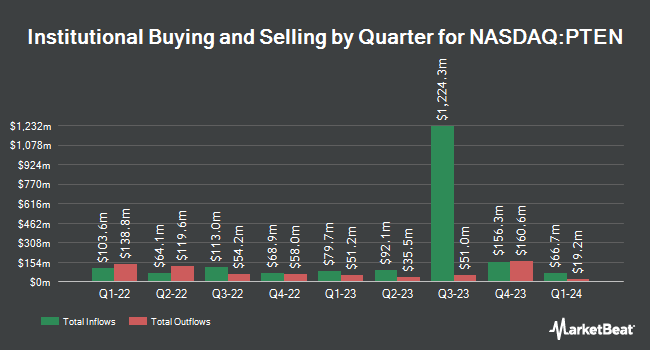Boston Partners bought a new position in shares of Patterson-UTI Energy, Inc. (NASDAQ:PTEN - Free Report) in the first quarter, according to the company in its most recent 13F filing with the Securities and Exchange Commission (SEC). The fund bought 78,193 shares of the oil and gas company's stock, valued at approximately $643,000.
Several other large investors have also modified their holdings of PTEN. Fuller & Thaler Asset Management Inc. raised its position in shares of Patterson-UTI Energy by 89.1% during the 4th quarter. Fuller & Thaler Asset Management Inc. now owns 16,954,738 shares of the oil and gas company's stock worth $140,046,000 after purchasing an additional 7,989,877 shares during the last quarter. ARGA Investment Management LP increased its position in Patterson-UTI Energy by 25.2% during the first quarter. ARGA Investment Management LP now owns 12,784,573 shares of the oil and gas company's stock worth $105,089,000 after buying an additional 2,569,713 shares in the last quarter. Northern Trust Corp raised its holdings in shares of Patterson-UTI Energy by 4.1% in the fourth quarter. Northern Trust Corp now owns 4,288,829 shares of the oil and gas company's stock worth $35,426,000 after acquiring an additional 170,417 shares during the last quarter. Nuveen LLC purchased a new stake in shares of Patterson-UTI Energy in the first quarter valued at $22,563,000. Finally, Nuveen Asset Management LLC increased its position in Patterson-UTI Energy by 66.5% during the 4th quarter. Nuveen Asset Management LLC now owns 2,506,536 shares of the oil and gas company's stock worth $20,704,000 after purchasing an additional 1,000,702 shares in the last quarter. 97.91% of the stock is currently owned by institutional investors and hedge funds.
Patterson-UTI Energy Trading Down 1.7%
Shares of PTEN stock traded down $0.09 during mid-day trading on Wednesday, reaching $5.29. The company's stock had a trading volume of 8,341,355 shares, compared to its average volume of 8,920,163. The company has a quick ratio of 1.50, a current ratio of 1.73 and a debt-to-equity ratio of 0.37. The firm has a market capitalization of $2.04 billion, a PE ratio of -1.92 and a beta of 1.30. The company's 50 day simple moving average is $5.98 and its 200-day simple moving average is $6.62. Patterson-UTI Energy, Inc. has a 12-month low of $5.12 and a 12-month high of $9.66.
Patterson-UTI Energy (NASDAQ:PTEN - Get Free Report) last announced its quarterly earnings results on Wednesday, July 23rd. The oil and gas company reported ($0.06) earnings per share (EPS) for the quarter, missing the consensus estimate of ($0.04) by ($0.02). Patterson-UTI Energy had a negative net margin of 21.49% and a negative return on equity of 1.94%. The company had revenue of $1.22 billion during the quarter, compared to analyst estimates of $1.24 billion. During the same quarter in the prior year, the company posted $0.03 earnings per share. The firm's revenue for the quarter was down 9.6% on a year-over-year basis. On average, research analysts predict that Patterson-UTI Energy, Inc. will post -0.1 EPS for the current fiscal year.
Patterson-UTI Energy Dividend Announcement
The business also recently declared a quarterly dividend, which will be paid on Monday, September 15th. Shareholders of record on Tuesday, September 2nd will be issued a $0.08 dividend. This represents a $0.32 dividend on an annualized basis and a yield of 6.0%. The ex-dividend date is Tuesday, September 2nd. Patterson-UTI Energy's dividend payout ratio is currently -11.59%.
Analyst Ratings Changes
A number of research firms have issued reports on PTEN. Royal Bank Of Canada reduced their target price on shares of Patterson-UTI Energy from $9.00 to $8.50 and set an "outperform" rating on the stock in a report on Friday, July 25th. Citigroup restated a "neutral" rating and set a $6.50 target price on shares of Patterson-UTI Energy in a research report on Monday, May 19th. JPMorgan Chase & Co. cut their price target on Patterson-UTI Energy from $9.00 to $7.00 and set a "neutral" rating for the company in a report on Wednesday, May 28th. Stifel Nicolaus decreased their price objective on Patterson-UTI Energy from $12.00 to $10.00 and set a "buy" rating on the stock in a report on Friday, July 25th. Finally, Barclays lowered their price objective on Patterson-UTI Energy from $8.00 to $7.00 and set an "overweight" rating for the company in a research report on Tuesday, July 29th. Five research analysts have rated the stock with a Buy rating and six have issued a Hold rating to the company. According to data from MarketBeat.com, Patterson-UTI Energy currently has a consensus rating of "Hold" and an average price target of $8.27.
Check Out Our Latest Stock Analysis on PTEN
Patterson-UTI Energy Company Profile
(
Free Report)
Patterson-UTI Energy, Inc, through its subsidiaries, engages in the provision of contract drilling services to oil and natural gas operators in the United States and internationally. It operates through three segments: Drilling Services, Completion Services, and Drilling Products. The Contract Drilling Services segment provides contract and directional drilling services in onshore oil and natural gas basins, as well as engages in the service and re-certification of equipment for drilling contractors, and provision of electrical controls and automation to the energy, marine and mining industries.
See Also

Before you consider Patterson-UTI Energy, you'll want to hear this.
MarketBeat keeps track of Wall Street's top-rated and best performing research analysts and the stocks they recommend to their clients on a daily basis. MarketBeat has identified the five stocks that top analysts are quietly whispering to their clients to buy now before the broader market catches on... and Patterson-UTI Energy wasn't on the list.
While Patterson-UTI Energy currently has a Hold rating among analysts, top-rated analysts believe these five stocks are better buys.
View The Five Stocks Here
Discover the 10 Best High-Yield Dividend Stocks for 2025 and secure reliable income in uncertain markets. Download the report now to identify top dividend payers and avoid common yield traps.
Get This Free Report
Like this article? Share it with a colleague.
Link copied to clipboard.